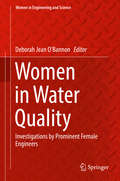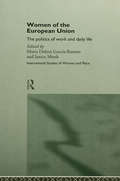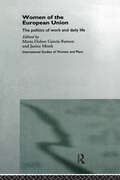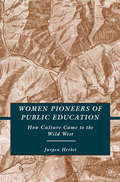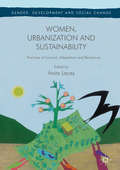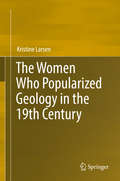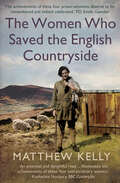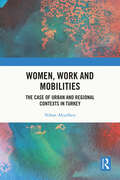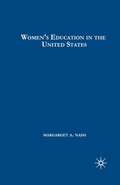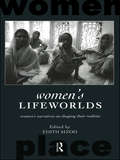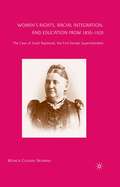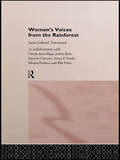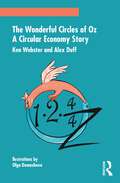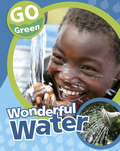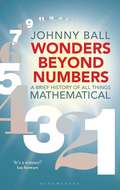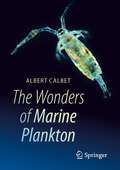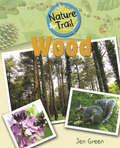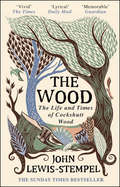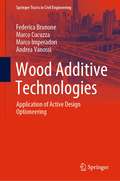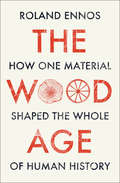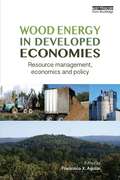- Table View
- List View
Women in Water Quality: Investigations by Prominent Female Engineers (Women in Engineering and Science)
by Deborah Jean O’BannonThis volume captures the impact of women’s research on the public health and environmental engineering profession. The volume is written as a scholarly text to demonstrate that women compete successfully in the field, dating back to 1873. Each authors’ chapter includes a section on her contribution to the field and a biography written for a general audience. This volume also includes a significant representation of early women’s contributions, highlighting their rich history in the profession. The book covers topics such as drinking water and health, biologically-active compounds, wastewater management, and biofilms. This volume should be of interest to academics, researchers, consulting engineering offices, and engineering societies while also inspiring young women to persist in STEM studies and aspire to academic careers.Features a blend of innovations and contributions made by women in water quality engineering, as well as their path to success, including challenges in their journeysPresents an opportunity to learn about the breadth and depth of the field of water qualityIncludes a history of women in water quality engineering as well as research in current issues such as urban water quality, biologically-active compounds, and biofilms
Women of the European Union: The Politics of Work and Daily Life (Routledge International Studies of Women and Place)
by Maria Dolors Garcia-Ramon Janice MonkWomen of the European Union challenges gender-blind assessments of the economic and social aspects of the European Union policies to examine the real implications of Union for the diversity of women in the Member States.The authors also analyze how women's work and daily lives are shaped by local and national policies, by local and global economic conditions, and by diverse and changing cultural values.Detailed contemporary case studies explore how place comes together with class, life stage, sexuality and ethnicity to affect the way in which women are constrained and how they develop strategies to manage their lives.
Women of the European Union: The Politics of Work and Daily Life (Routledge International Studies of Women and Place)
by Maria Dolors García-Ramon Janice MonkWomen of the European Union challenges gender-blind assessments of the economic and social aspects of the European Union policies to examine the real implications of Union for the diversity of women in the Member States.The authors also analyze how women's work and daily lives are shaped by local and national policies, by local and global economic conditions, and by diverse and changing cultural values.Detailed contemporary case studies explore how place comes together with class, life stage, sexuality and ethnicity to affect the way in which women are constrained and how they develop strategies to manage their lives.
Women Pioneers of Public Education: How Culture Came to the Wild West
by J. HerbstThe book narrates the story of how the school, founded by women pioneers of public education in a Rocky Mountain mining settlement, became the centre and sustaining force of the town's community life from its beginning in the 1870s to the present day.
Women, Urbanization and Sustainability: Practices of Survival, Adaptation and Resistance (Gender, Development and Social Change)
by Anita LaceyThis work considers the city as a gendered space and examines women’s experiences and engagement in both urbanization and sustainability. Such a focus offers distinctive insights into the question of what it means for a city to be sustainable, asking further how sustainability needs to work with gender and the gendered lives of cities’ inhabitants. Vitally, it considers women’s lives in cities and their work to forge more sustainable cities through a wide variety of means, including governmental, non-governmental and local grassroots and individual efforts towards sustainable urban life. The volume is transnational, offering case-studies from a wide range of city sites and sustainability efforts. It explores crucial questions such as the gendered nature and women’s experiences of current urbanization; the gendered nature of urban sustainability thinking and programmes; and local alternatives and resistances to dominant modes of addressing urbanization challenges.
The Women Who Popularized Geology in the 19th Century
by Kristine LarsenThe female authors highlighted in this monograph represent a special breed of science writer, women who not only synthesized the science of their day (often drawing upon their own direct experience in the laboratory, field, classroom, and/or public lecture hall), but used their works to simultaneously educate, entertain, and, in many cases, evangelize. Women played a central role in the popularization of science in the 19th century, as penning such works (written for an audience of other women and children) was considered proper "women's work." Many of these writers excelled in a particular literary technique known as the "familiar format," in which science is described in the form of a conversation between characters, especially women and children. However, the biological sciences were considered more “feminine” than the natural sciences (such as astronomy and physics), hence the number of geological “conversations” was limited. This, in turn, makes the few that were completed all the more crucial to analyze.
The Women Who Saved the English Countryside
by Matthew KellyA vibrant history of English landscape preservation over the last 150 years, told through the lives of four remarkable women In Britain today, a mosaic of regulations protects the natural environment and guarantees public access to green spaces. But this was not always so. Over the last 150 years, activists have campaigned tirelessly for the right to roam through the countryside and the vital importance of preserving Britain’s natural beauty. Matthew Kelly traces the history of landscape preservation through the lives of four remarkable women: Octavia Hill, Beatrix Potter, Pauline Dower, and Sylvia Sayer. From the commons of London to the Lake District, Northumberland, and Dartmoor, these women protected the English landscape at a crucial period through a mixture of environmental activism, networking, and sheer determination. They grappled with the challenges that urbanization and industrial modernity posed to human well-being as well as the natural environment. By tirelessly seeking to reconcile the needs of particular places to the broader public interest they helped re-imagine the purpose of the English countryside for the democratic age.
Women, Work and Mobilities: The case of urban and regional contexts in Turkey
by Nihan AkyelkenThis book explores the wider implications of how workers move within and across cities and regions to reach economic opportunities. It does so with a specific focus on women in urban and regional contexts in Turkey. The book reveals specificities and generalisations about mobility patterns of women in low-income households/low-paid jobs and how these change in the existence of urban and regional interventions, such as industrial zoning, urban transformations and mobility restrictions. The book presents new theorisations of work and mobility through labour agency, showing how mobility changes the recruitment and use of labour under state interventions. It orchestrates the existing narratives of containment, mobility and rootedness to shed light on the role of labour agency in organising livelihoods. The book particularly acknowledges the multiscale, multifaceted and relational nature of mobilities entailed in the economy by bringing the role of labour agency into urban and regional contexts. This book will appeal to researchers and students working on labour geography, feminist geography, mobilities and urban studies.
Women, Work and Mobilities: The case of urban and regional contexts in Turkey
by Nihan AkyelkenThis book explores the wider implications of how workers move within and across cities and regions to reach economic opportunities. It does so with a specific focus on women in urban and regional contexts in Turkey. The book reveals specificities and generalisations about mobility patterns of women in low-income households/low-paid jobs and how these change in the existence of urban and regional interventions, such as industrial zoning, urban transformations and mobility restrictions. The book presents new theorisations of work and mobility through labour agency, showing how mobility changes the recruitment and use of labour under state interventions. It orchestrates the existing narratives of containment, mobility and rootedness to shed light on the role of labour agency in organising livelihoods. The book particularly acknowledges the multiscale, multifaceted and relational nature of mobilities entailed in the economy by bringing the role of labour agency into urban and regional contexts. This book will appeal to researchers and students working on labour geography, feminist geography, mobilities and urban studies.
Women's Education in the United States, 1780-1840
by M. NashPlease note this is a 'Palgrave to Order' title. Stock of this book requires shipment from overseas. It will be delivered to you within 12 weeks. Winner of 2005 American Educational Studies Association (AESA) Critic's Choice Award, this is a groundbreaking from Margaret Nash examining the development of women's education.
Women's Lifeworlds: Women's Narratives on Shaping their Realities
by Edith SizooWomen's Lifeworlds explores the diversity and complexity of women's perceptions and reactions to their own 'lifeworlds' in their own words. Examining the changing meaning of 'place' in women's lives over time and across space, this book questions how women face, negotiate and shape the social space of their environment. Engaging personal narratives are presented by fifteen women of various age groups, from different cultural, religious, social and geographical backgrounds, from Mexican politician, Muslim psychiatrist, Finnish housewife to Indian guru and African rural woman. Writing about the lives of their grandmothers, mothers, themselves, their daughters or other close female relatives, the authors of these life narratives cross generational and cultural divides and share perceptions with each other. This unique inter-generational approach provides an engaging challenge to the generalised assumptions of how women in various historical and cultural contexts feel about womanhood, life, society, culture and religion.
Women's Lifeworlds: Women's Narratives on Shaping their Realities
by Edith SizooWomen's Lifeworlds explores the diversity and complexity of women's perceptions and reactions to their own 'lifeworlds' in their own words. Examining the changing meaning of 'place' in women's lives over time and across space, this book questions how women face, negotiate and shape the social space of their environment. Engaging personal narratives are presented by fifteen women of various age groups, from different cultural, religious, social and geographical backgrounds, from Mexican politician, Muslim psychiatrist, Finnish housewife to Indian guru and African rural woman. Writing about the lives of their grandmothers, mothers, themselves, their daughters or other close female relatives, the authors of these life narratives cross generational and cultural divides and share perceptions with each other. This unique inter-generational approach provides an engaging challenge to the generalised assumptions of how women in various historical and cultural contexts feel about womanhood, life, society, culture and religion.
Women’s Rights, Racial Integration, and Education from 1850–1920: The Case of Sarah Raymond, the First Female Superintendent
by M. NoraianThis historical biography examines Sarah Raymond Fitzwilliam's abolitionist roots growing up on a stop of the Underground Railroad, her training at a 'normal school,' her tenure as a teacher, principal and the nation's first city school superintendent (Bloomington, Illinois 1874-1892).
Women's Voices from the Rainforest (Routledge International Studies of Women and Place)
by Janet Gabriel TownsendWomen's Voices from the Rainforest explores the position of the women whose families are tearing down the rainforest. These women of Central and Latin America have been largely invisible until now, but they are at last turning their voices into action.International development policy and its top-down culture must take much of the blame for environmental and social destruction of the rainforest. Presenting the contrasting results of different methodologies, a comprehensive literature review, and the voices of the rainforest women themselves, told in life histories, the authors argue for the adoption of "grassroots" strategies, not international solutions.
Women's Voices from the Rainforest (Routledge International Studies of Women and Place)
by Janet Gabriel TownsendWomen's Voices from the Rainforest explores the position of the women whose families are tearing down the rainforest. These women of Central and Latin America have been largely invisible until now, but they are at last turning their voices into action.International development policy and its top-down culture must take much of the blame for environmental and social destruction of the rainforest. Presenting the contrasting results of different methodologies, a comprehensive literature review, and the voices of the rainforest women themselves, told in life histories, the authors argue for the adoption of "grassroots" strategies, not international solutions.
The Wonderful Circles of Oz: A Circular Economy Story
by Ken Webster Alex DuffWith the world’s economies impacted by coronavirus, billions are feeling social, environmental, and economic injustices. The call for a new, more just, more distributive economic story and system is louder and more urgent than ever. The Wonderful Circles of Oz provides both the framework and solutions for navigating towards an effective circular economy – the gateway to an abundant, autonomous, and democratic future. Widely regarded as one of the world’s most engaging circular economy thought leaders, Ken Webster, together with creative writer, Alex Duff, use a storytelling approach based on The Wonderful Wizard of Oz to offer a new, accessible, and compelling narrative about the future direction of our economy. ‘The harder you work, the more you’ll improve your lot.’ That’s the simple story we’ve been sold over the last 40 years to justify how today’s economy works. Yet extreme inequality, the devastation of our natural world, and the erosion of our communities tell us this economic story resembles a work of fiction and the way our extractive economy operates is not fit for purpose. Still a restoration narrative, a satisfying story about our future and how we’ll get there, is slow to emerge. Using allegory, commentary, and reflection, this book helps speed the shift from an extractive economy of materials, energy, and finance to one based on an effective circular economy, which builds wealth as a stock of solutions accessible to all. The Wonderful Circles of Oz goes beyond tired debates (capital vs labour and market vs state) and blends fiction and non to effectively communicate the need for macro-economic system redesign. Exploring complex change and containing echoes of modern monetary theory, this book is a must for business professionals, students, and anyone with an interest in the circular economy.
The Wonderful Circles of Oz: A Circular Economy Story
by Ken Webster Alex DuffWith the world’s economies impacted by coronavirus, billions are feeling social, environmental, and economic injustices. The call for a new, more just, more distributive economic story and system is louder and more urgent than ever. The Wonderful Circles of Oz provides both the framework and solutions for navigating towards an effective circular economy – the gateway to an abundant, autonomous, and democratic future. Widely regarded as one of the world’s most engaging circular economy thought leaders, Ken Webster, together with creative writer, Alex Duff, use a storytelling approach based on The Wonderful Wizard of Oz to offer a new, accessible, and compelling narrative about the future direction of our economy. ‘The harder you work, the more you’ll improve your lot.’ That’s the simple story we’ve been sold over the last 40 years to justify how today’s economy works. Yet extreme inequality, the devastation of our natural world, and the erosion of our communities tell us this economic story resembles a work of fiction and the way our extractive economy operates is not fit for purpose. Still a restoration narrative, a satisfying story about our future and how we’ll get there, is slow to emerge. Using allegory, commentary, and reflection, this book helps speed the shift from an extractive economy of materials, energy, and finance to one based on an effective circular economy, which builds wealth as a stock of solutions accessible to all. The Wonderful Circles of Oz goes beyond tired debates (capital vs labour and market vs state) and blends fiction and non to effectively communicate the need for macro-economic system redesign. Exploring complex change and containing echoes of modern monetary theory, this book is a must for business professionals, students, and anyone with an interest in the circular economy.
Wonderful Water: Wonderful Water (Go Green #2)
by Helen Lanz'Go Green: Wonderful Water' looks at our world's most precious resource - water - and explains the steps we can all take to save it every day.Packed with statistics, useful information and handy tips, each title in the tells us what steps we can all take to `go green`.
Wonders Beyond Numbers: A Brief History of All Things Mathematical
by Johnny BallIn this book, Johnny Ball tells one of the most important stories in world history – the story of mathematics. By introducing us to the major characters and leading us through many historical twists and turns, Johnny slowly unravels the tale of how humanity built up a knowledge and understanding of shapes, numbers and patterns from ancient times, a story that leads directly to the technological wonderland we live in today. As Galileo said, 'Everything in the universe is written in the language of mathematics', and Wonders Beyond Numbers is your guide to this language. Mathematics is only one part of this rich and varied tale; we meet many fascinating personalities along the way, such as a mathematician who everyone has heard of but who may not have existed; a Greek philosopher who made so many mistakes that many wanted his books destroyed; a mathematical artist who built the largest masonry dome on earth, which builders had previously declared impossible; a world-renowned painter who discovered mathematics and decided he could no longer stand the sight of a brush; and a philosopher who lost his head, but only after he had died. Enriched with tales of colourful personalities and remarkable discoveries, there is also plenty of mathematics for keen readers to get stuck into. Written in Johnny Ball's characteristically light-hearted and engaging style, this book is packed with historical insight and mathematical marvels; join Johnny and uncover the wonders found beyond the numbers.
The Wonders of Marine Plankton
by Albert CalbetMarine plankton, despite their tiny size, are crucial for the functioning of marine food webs. It is not just about one organism eating another; when this happens, it helps release the nutrients accumulated within living matter, making them available again for microalgae. Plankton are present in freshwater and in all the seas and oceans on the planet. Moreover, they are responsible for supporting life on Earth and has provided us (on geological timescales) with a significant portion of the oxygen we breathe. In just a small spoonful of seawater, we can find around fifty million viruses, five million bacteria, hundreds of thousands of small unicellular flagellates, thousands of microscopic algae, five heterotrophic ciliates or dinoflagellates, and, with some luck, a small crustacean like copepods. This book aims to bridge the gap between scientific research and the general public, offering a captivating exploration of the fascinating world of marine plankton. Through engaging narratives and visually compelling illustrations, readers will gain insights into the importance of plankton in marine ecosystems, their diverse forms, and the crucial role they play in maintaining our planet's health.
Wood: Wood (Nature Trail #1)
by Jen GreenThe purpose of this series is to show children the habitats around them. The books will guide a child through their personal exploration of different habitats. The reader will be encouraged to use key science skills to plan, observe, collect, record and and preserve their findings on their trail of nature.
The Wood: The Life & Times of Cockshutt Wood
by John Lewis-StempelTHE SUNDAY TIMES BESTSELLER by 'Indisputably, one of the best nature-writers of his generation' (Country Life) BBC Radio 4 'Book of the Week' Written in diary format, The Wood is the story of English woodlands as they change with the seasons. Lyrical and informative, steeped in poetry and folklore, The Wood inhabits the mind and touches the soul.For four years John Lewis-Stempel managed Cockshutt wood, a particular wood - three and half acres of mixed woodland in south west Herefordshire - that stands as exemplar for all the small woods of England. John coppiced the trees and raised cows and pigs who roamed free there. This is the diary of the last year, by which time he had come to know it from the bottom of its beech roots to the tip of its oaks, and to know all the animals that lived there - the fox, the pheasants, the wood mice, the tawny owl - and where the best bluebells grew. For many fauna and flora, woods like Cockshutt are the last refuge. It proves a sanctuary for John too. To read The Wood is to be amongst its trees as the seasons change, following an easy path until, suddenly the view is broken by a screen of leaves, or your foot catches on a root, or a bird startles overhead. This is a wood you will never want to leave.
Wood Additive Technologies: Application of Active Design Optioneering (Springer Tracts in Civil Engineering)
by Marco Imperadori Federica Brunone Marco Cucuzza Andrea VanossiThe book encodes a vision for the actively sustainable management and development of the built environment by referring to the application of timber-based construction systems as additive solutions for the multi-purpose improvement of existing buildings. It translates this vision into an innovative methodology for the management of the entire building process – from design to production, operation, and maintenance - and the assessment of timber-based construction performances across the whole building life-cycle. This approach is based on a multi-dimensional analysis, which starts from the structure of the Active House (AH) protocol, improved through information-integrated digital environments and multi-criteria evaluation methods, such as BIM and Design Optioneering. During the design stage, indeed, it analyzes and compares different design choices, according to the DO method, until the definition and validation of the “As-Built” step, while in the operational phase, it refers to sensors-retrieved data to show the evolution of the building behaviour, accounting for real users’ interaction, building performances decay and needs of maintenance, defining the digital twin of the building: a real Cognitive Building. Finally, the application of this methodology identifies innovative models of processes, products, and design of wood-based construction technologies, suitable to satisfy the needs of the 2D/3D construction layering for the sustainable transformation of the built environment.
The Wood Age: How One Material Shaped The Whole Of Human History
by Roland EnnosRoland Ennos’ The Wood Age is a love-letter to the world’s most vital and yet most threatened material. It is the story of how wood has shaped our human experience from the earliest foragers to the modern four poster bed.
Wood Energy in Developed Economies: Resource Management, Economics and Policy
by Francisco X. AguilarThere has been a recent resurgence of interest in wood energy as part of a sustainable range of renewable energy options. This book addresses the current gap in the energy and public policy literature for a reference book that compiles the most-recent wood energy assessments, and evaluates current and potential future wood energy uses and the role for public policy to foster efficient use of the most-widely consumed renewable energy in the world. It brings together a group of expert authors covering topics from forest management, operations and engineering, to socio-economics and energy policy perspectives. It thus covers practical issues such as silviculture, harvesting, processing, comparative cost estimates, public policy tools and market effects. As such the book provides a comprehensive review of the complex dimensions of wood energy as well as practical guidance for professionals, researchers and advanced students. It will also provide invaluable guidance for economic development agencies, practitioners and policy-makers, when evaluating the impacts of wider wood energy adoption as part of a strategy for sustainable energy generation. The main focus is on industrialised production and developed economies, particularly the USA and Europe.
